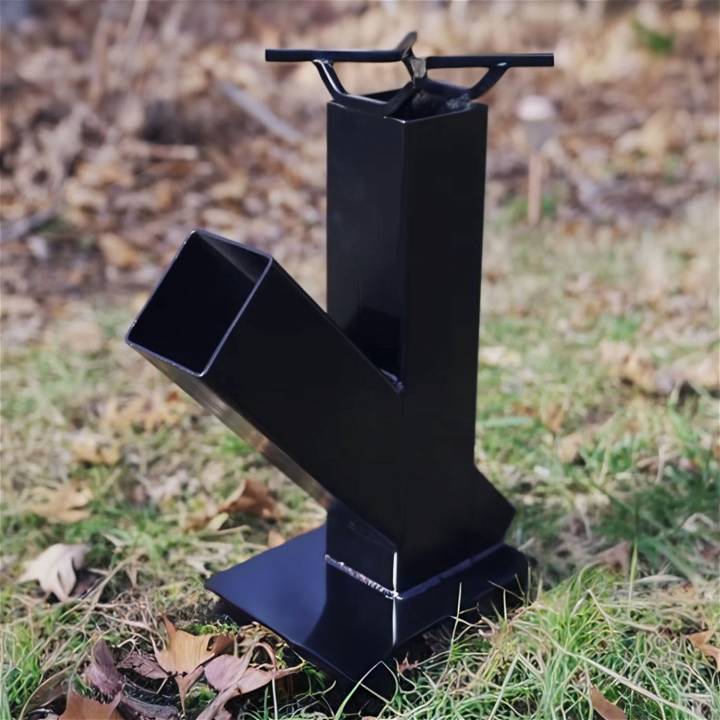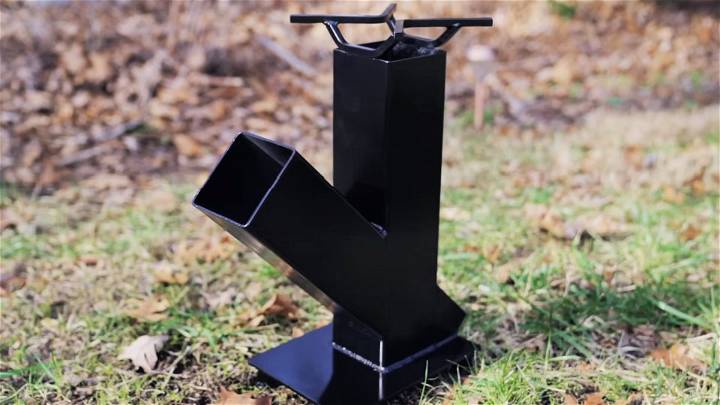A DIY rocket stove is a highly efficient and eco-friendly cooking solution that you can easily build at home. The rocket stove design uses a small combustion chamber to burn wood fast and hot, minimizing smoke and maximizing heat. This DIY rocket stove design is perfect for outdoor cooking, camping trips, or emergency preparedness. By using minimal materials, you can make a powerful stove that drastically reduces your wood consumption.

Building a rocket stove is an engaging and rewarding project that combines basic skills with practical benefits. From gathering materials to following construction steps, the process is straightforward and economical. Whether you need a reliable cooking source for camping or a backup for emergencies, this stove has you covered.
Learn how to build an efficient DIY rocket stove. Follow our easy guide to make your own eco-friendly stove for outdoor cooking and heating.
Benefits of Using a Rocket Stove
Rocket stoves are an innovative solution for efficient cooking and heating, offering numerous benefits that make them a popular choice for people around the world. Here's why you might consider using a rocket stove:
- Fuel Efficiency: Rocket stoves are designed to burn small pieces of wood very efficiently, which means you'll use less fuel compared to traditional open fires or stoves. This can save you money and reduce the need for fuel gathering.
- Reduced Smoke and Emissions: Thanks to their efficient combustion process, rocket stoves produce significantly less smoke than conventional stoves. This means better air quality and fewer health risks associated with smoke inhalation.
- Quick Cooking: The concentrated heat in a rocket stove allows for faster cooking times. You can boil water or cook meals more quickly, saving you time and making it more convenient.
- Portability: Many rocket stoves are lightweight and portable, making them ideal for camping trips or outdoor cooking. You can easily take them with you wherever you go.
- Minimal Environmental Impact: By using less wood, rocket stoves help to reduce deforestation and carbon emissions. They are a more sustainable option that contributes to environmental conservation.
- Cost-Effective: Rocket stoves are relatively inexpensive to build or buy, and they can be made from readily available materials. Their fuel efficiency also means ongoing savings in fuel costs.
- Durability: When built correctly, rocket stoves are sturdy and can last a long time, even with frequent use. This makes them a reliable cooking solution for years to come.
- Versatility: You can use a rocket stove for a variety of cooking methods, including boiling, frying, and grilling. Some designs even allow for baking.
Materials Needed:
Before we begin, it's crucial to gather all the necessary materials. Each component plays a pivotal role in the functionality and efficiency of our rocket stove.
- Steel Body: The core of our stove. I used an old piece of steel, which makes recycling and repurposing key. Its durability and heat resistance are essential.
- Mesh Grate: For supporting the wood and ensuring proper airflow. I chose a fine steel mesh, doubling it up for extra support.
- Welding Tools: Crucial for joining the pieces together. If welding seems daunting, remember, with practice, it becomes manageable.
- Safety Gear: Always prioritize safety with gloves, goggles, and protective clothing.
Understanding the role of each material helps us appreciate their contribution to our rocket stove's effectiveness.
Step by Step Instructions
Learn how to build a DIY rocket stove with step-by-step instructions. Prepare the steel body, assemble the base, install the mesh grate, and complete the final assembly.
Step 1: Preparing the Steel Body
The journey begins with preparing the steel body. Precision is key here; your cuts define the stove's structure. The main body requires two significant holes: one for feeding the wood and the other for air inlet. A common mistake is to compromise on the air inlet size, but full access ensures better airflow, enhancing the combustion process. Remember, attention to detail at this stage sets the foundation for your stove's functionality.
Step 2: Assembling the Base
The base offers stability and should be robust. I repurposed an old steel piece, demonstrating that sustainability and practicality can go hand in hand. This stage is about vision; envisioning the base not just as a support but as an integral part of the stove's overall design. If your base piece has imperfections, like mine did with two pre-existing holes, don't hesitate to weld them shut. Every challenge is an opportunity for refinement.
Step 3: Installing the Mesh Grate
The mesh grate plays a dual role: supporting the wood and facilitating airflow. Cutting the mesh to fit and doubling it for added strength ensures that the wood does not obstruct the air chamber. This might seem like a small detail, but its impact on efficient combustion is huge. It's about building the perfect environment for fire to thrive, right within our stove.
Step 4: Final Assembly and Welding
Now, with all pieces prepared, it's time for assembly. This final step is where your project comes to life. Welding requires patience and precision. Align each component carefully, ensuring the structure is solid. Here, practice indeed makes perfect. The goal is not just to join the pieces but to do so in a way that assures durability and resilience.
Personal Insights:
Building this rocket stove was more than a project; it was a journey in patience, innovation, and sustainability. From selecting and preparing the materials to the final assembly, each step was a learning curve. What stood out the most was the effectiveness of keeping the entire front for the wood chute, maximizing the size for wood input, which was an idea generated through wonderful interactions with fellow outdoor enthusiasts.
Finishing the stove felt triumphant. It was efficient, practical, and a personal innovation. Cooking bacon outdoors wasn't just tasty but satisfying, using something made by hand.
Customization Ideas for Your Rocket Stove
Making a rocket stove that meets your specific needs and preferences is not only practical but can also be a fun project. Here are some customization ideas to help you personalize your rocket stove:
- Choose Your Materials: You can build a rocket stove from various materials like bricks, metal cans, or even concrete. Select materials that are easily accessible and fit the aesthetic you desire.
- Size and Portability: Decide on the size of your rocket stove based on its intended use. For camping, a small and portable design might be best. For home use, a larger, more permanent structure could be more suitable.
- Cooking Surface: Customize the cooking surface to accommodate the types of pots and pans you'll use. Some people prefer a flat top for versatility, while others might want a specific shape for certain cookware.
- Decorative Elements: Add a personal touch with decorative tiles, paint, or metalwork. This can transform your rocket stove from a purely functional item into a conversation piece.
- Integrated Features: Consider integrating features like a griddle, a baking oven, or a water heating coil. These additions can expand the functionality of your rocket stove beyond simple cooking.
- Adjustable Airflow: Implementing a way to adjust the airflow can help you control the temperature more precisely, making your cooking experience better.
- Insulation: Use materials like vermiculite or perlite to insulate your stove. Good insulation improves efficiency and heat retention.
- Safety Features: Incorporate safety features such as a spark arrestor or a stable base to prevent accidents.
Consider these customization ideas to build a rocket stove that looks great and performs as needed.

Common Mistakes to Avoid When Using a Rocket Stove
When it comes to rocket stoves, a little know-how goes a long way. Avoiding common mistakes can make your experience safer and more enjoyable. Here are some key points to keep in mind:
- Ignoring Safety Precautions: Always prioritize safety. Use the stove in a well-ventilated area to prevent smoke inhalation and ensure the stove is stable to prevent tipping.
- Using Wet or Green Wood: For efficient burning, use dry, seasoned wood. Wet or green wood makes more smoke and less heat, defeating the purpose of the stove.
- Overloading the Stove: Don't overfill the combustion chamber. It needs air to circulate for optimal combustion. A smaller, hotter fire is better than a large, smoky one.
- Neglecting Maintenance: Regularly clean out ash and soot buildup. This maintains airflow and efficiency and extends the life of your stove.
- Improper Lighting Technique: Start with smaller kindling and gradually add larger pieces of wood. This helps establish a strong, steady flame.
- Ignoring Local Regulations: Some areas have specific rules about outdoor fires. Check local regulations to ensure you're using your rocket stove legally.
- Unattended Use: Never leave a burning stove unattended. Always extinguish the fire completely before leaving the area.
Avoid these mistakes to maximize your rocket stove. Understand how it works and follow fire management basics.
Troubleshooting Guide for Rocket Stoves
Encountering issues with your rocket stove can be frustrating, but most problems have simple solutions. Here's a troubleshooting guide to help you resolve common issues:
The Stove Isn't Drawing Properly
- Solution: Check for obstructions in the chimney or air intake. Ensure the fuel feed is not overloaded and that there's enough space for air to flow.
Smoke Is Coming Out of the Feed Tube
- Solution: This often means the combustion chamber is not hot enough. Make sure you're using dry, seasoned wood and that the stove has been properly primed with a good flame.
The Fire Keeps Going Out
- Solution: Maintain a balance between fuel size and quantity. Too much can smother the flame, and too little can cause it to die down. Adjust the wood size and feeding rate.
The Stove Is Too Smoky
- Solution: Ensure the wood is dry and well-seasoned. If the problem persists, check for blockages in the chimney and clean if necessary.
The Stove Is Not Producing Enough Heat
- Solution: Increase the insulation around the combustion chamber. You can also try using hardwoods, which burn hotter than softwoods.
Difficulty Lighting the Stove
- Solution: Use smaller pieces of kindling to start the fire before adding larger pieces. Ensure the air intake is fully open to provide enough oxygen.
Follow these tips to solve most rocket stove issues. The key is maintaining it well and managing the fire effectively.
Maintenance and Care for Your Rocket Stove
Taking care of your rocket stove is essential for its longevity and efficiency. Here's a straightforward guide to maintaining your rocket stove:
- Regular Cleaning: After each use, once the stove has cooled down, remove ash and unburned fuel. This prevents blockages and maintains good airflow, which is crucial for efficient burning.
- Inspect for Damage: Periodically check your stove for cracks or wear, especially if it's made from metal, which can corrode over time. Repair any damage promptly to ensure safety and performance.
- Protect from Weather: If your rocket stove is outdoors, cover it when not in use to protect it from rain and snow. Moisture can damage the stove and affect its functionality.
- Store Fuel Properly: Keep your wood dry and protected from the elements. Dry wood burns hotter and cleaner, making your stove more effective.
- Monitor Combustion: Watch the flame and smoke. A well-functioning rocket stove should have a hot, concentrated flame with minimal smoke. If this isn't the case, troubleshoot to find the cause.
- Clean the Chimney: If your stove has a chimney, clean it regularly to remove soot and creosote buildup, which can be a fire hazard.
- Use the Right Fuel: Stick to the recommended fuel types for your stove. Avoid treated wood or trash, as burning these can release harmful chemicals.
Simple maintenance ensures your rocket stove stays reliable and efficient for cooking and warmth. A bit of upkeep preserves its function and safety.
FAQs About Free Rocket Stove Plans
Explore our FAQs about free rocket stove plans to find answers to questions about materials, construction, and efficient design for eco-friendly outdoor cooking solutions.
A rocket stove is characterized by its efficient use of fuel and low emissions. It’s designed to direct airflow and fuel combustion in a way that produces intense heat with minimal smoke, making it ideal for cooking outdoors or in areas without access to electricity or gas.
Yes, there are many designs available, ranging from simple, portable models made from cans to more complex, permanent structures. Some designs include features like grates or pots specifically made for cooking, while others are more basic and provide a heat source.
When built and used correctly, rocket stoves are safe. They should be used outdoors or in well-ventilated areas to prevent carbon monoxide buildup. Always ensure the stove is stable and that flammable materials are kept away from the heat source.
Rocket stoves are highly efficient, using less fuel than traditional open fires and producing less smoke. This makes them environmentally friendly and cost-effective. They’re also portable, making them great for camping or emergency situations where traditional fuel sources aren’t available.
Using a rocket stove indoors requires careful consideration of ventilation and safety. Rocket stoves are primarily designed for outdoor use due to the risk of carbon monoxide poisoning in enclosed spaces. If you want to use one indoors, it must be properly vented to the outside, similar to a wood stove or fireplace. Additionally, check local building codes and regulations, as indoor use may not be permitted in some areas. Always prioritize safety and consult with a professional if you're unsure.
Wrapping Up:
Wrapping up, making your own DIY rocket stove design to build is both a practical and rewarding project. With a simple rocket stove design, you can enjoy efficient cooking and heating while using minimal resources. Remember to gather the right materials, follow the steps closely, and always prioritize safety. Get started on your DIY rocket stove and experience the benefits of a portable, eco-friendly solution.













